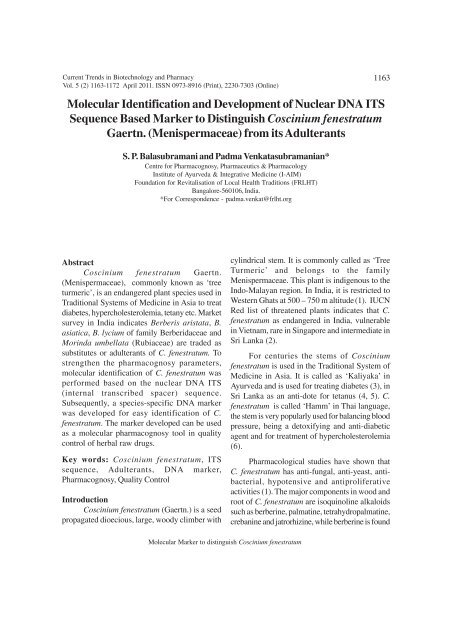Current Trends in <strong>Biotechnology</strong> <strong>and</strong> <strong>Pharmacy</strong>Vol. 5 (2) 1163-1172 April 2011. ISSN 0973-8916 (Print), 2230-7303 (Online)1163Molecular Identification <strong>and</strong> Development <strong>of</strong> Nuclear DNA ITSSequence Based Marker to Distinguish Coscinium fenestratumGaertn. (Menispermaceae) from its AdulterantsS. P. Balasubramani <strong>and</strong> Padma Venkatasubramanian*Centre for Pharmacognosy, Pharmaceutics & PharmacologyInstitute <strong>of</strong> Ayurveda & Integrative Medicine (I-AIM)Foundation for Revitalisation <strong>of</strong> Local Health Traditions (FRLHT)Bangalore-560106, India.*For Correspondence - padma.venkat@frlht.orgAbstractCoscinium fenestratum Gaertn.(Menispermaceae), commonly known as ‘treeturmeric’, is an endangered plant species used inTraditional Systems <strong>of</strong> Medicine in Asia to treatdiabetes, hypercholesterolemia, tetany etc. Marketsurvey in India indicates Berberis aristata, B.asiatica, B. lycium <strong>of</strong> family Berberidaceae <strong>and</strong>Morinda umbellata (Rubiaceae) are traded assubstitutes or adulterants <strong>of</strong> C. fenestratum. Tostrengthen the pharmacognosy parameters,molecular identification <strong>of</strong> C. fenestratum wasperformed based on the nuclear DNA ITS(internal transcribed spacer) sequence.Subsequently, a species-specific DNA markerwas developed for easy identification <strong>of</strong> C.fenestratum. The marker developed can be usedas a molecular pharmacognosy tool in qualitycontrol <strong>of</strong> herbal raw drugs.Key words: Coscinium fenestratum, ITSsequence, Adulterants, DNA marker,Pharmacognosy, Quality ControlIntroductionCoscinium fenestratum (Gaertn.) is a seedpropagated dioecious, large, woody climber withcylindrical stem. It is commonly called as ‘TreeTurmeric’ <strong>and</strong> belongs to the familyMenispermaceae. This plant is indigenous to theIndo-Malayan region. In India, it is restricted toWestern Ghats at 500 – 750 m altitude (1). IUCNRed list <strong>of</strong> threatened plants indicates that C.fenestratum as endangered in India, vulnerablein Vietnam, rare in Singapore <strong>and</strong> intermediate inSri Lanka (2).For centuries the stems <strong>of</strong> Cosciniumfenestratum is used in the Traditional System <strong>of</strong>Medicine in Asia. It is called as ‘Kaliyaka’ inAyurveda <strong>and</strong> is used for treating diabetes (3), inSri Lanka as an anti-dote for tetanus (4, 5). C.fenestratum is called ‘Hamm’ in Thai language,the stem is very popularly used for balancing bloodpressure, being a detoxifying <strong>and</strong> anti-diabeticagent <strong>and</strong> for treatment <strong>of</strong> hypercholesterolemia(6).Pharmacological studies have shown thatC. fenestratum has anti-fungal, anti-yeast, antibacterial,hypotensive <strong>and</strong> antiproliferativeactivities (1). The major components in wood <strong>and</strong>root <strong>of</strong> C. fenestratum are isoquinoline alkaloidssuch as berberine, palmatine, tetrahydropalmatine,crebanine <strong>and</strong> jatrorhizine, while berberine is foundMolecular Marker to distinguish Coscinium fenestratum
Current Trends in <strong>Biotechnology</strong> <strong>and</strong> <strong>Pharmacy</strong>Vol. 5 (2) 1163-1172 April 2011. ISSN 0973-8916 (Print), 2230-7303 (Online)1164to be the major <strong>and</strong> active constituent. It has beenshown to bind to DNA <strong>and</strong> inhibit its cleavage(7). Antibacterial, antileishmanial, antiplatelet, antidiarrhoeal,anti-protozoan, cardioprotective, anticancer,anti-inflammatory, anti-hepatotoxic,immunostimulatory <strong>and</strong> anti HIV properties havebeen reported with berberine (7).In India, market survey indicates thatBerberis aristata DC, B. asiatica Roxb., B.lycium Royle, <strong>and</strong> Morinda umbellata L. aretraded as adulterants or substitutes <strong>of</strong> C.fenestratum (1, 8). The annual trade combiningall the five species is estimated to be 500 – 1000MT (8). Morphologically intact C. fenestratumstems can be distinguished from the other ‘TreeTurmeric’ c<strong>and</strong>idates using the radical array inthe transverse section (3). However, when tradedas chips or in powder form it is not distinguishable.<strong>Biotechnology</strong>-driven applications play animportant role in modern pharmacognosy analysisfor herbal drug development <strong>and</strong> discovery.Current focus on chemotype-driven fingerprinting<strong>and</strong> related techniques requires integration withgenotype-driven molecular techniques so that anoptimal characterization <strong>of</strong> botanical materials ispossible (9). Chinese researchers have appliedDNA markers extensively for characterization <strong>of</strong>botanicals from the Chinese materia medica.These markers have shown remarkable utility inquality control <strong>of</strong> commercially importantbotanicals like Ginseng, Echinacea, Atractylodesetc (10).DNA markers to distinguish some <strong>of</strong> theauthentic <strong>and</strong> the adulterant medicinal plants usedin Indian System <strong>of</strong> medicine have also beenreported from our lab (11 – 13). ITS (InternalTranscribed Spacer) sequences have been shownto be a valuable source <strong>of</strong> evidence to resolvephylogenetic relationships in many angiospermgroups (14). ITS1 separates 18S <strong>and</strong> 5.8S, whileITS2 separates 5.8S <strong>and</strong> 26S rRNA genes.Because <strong>of</strong> their different rates <strong>of</strong> evolution, ITSregions have become the favored markers inevolutionary studies at different taxonomic levels(15). In recent times, these sequence variationsare used to develop species-specific markers foridentification <strong>and</strong> authentication <strong>of</strong> raw drugs <strong>and</strong>herbal formulations (16 – 18).The objective <strong>of</strong> the present study was toidentify C. fenestratum at molecular level <strong>and</strong> todevelop a species-specific marker based on ITSregion to distinguish from its adulterants.Materials <strong>and</strong> MethodsPlant material: Field <strong>and</strong> market samples <strong>of</strong>Berberis aristata, Berberis asiatica, Berberislycium, Coscinium fenestratum <strong>and</strong> Morindaumbellata, were collected from differentgeographical locations <strong>of</strong> India. The authenticity<strong>of</strong> the samples was confirmed by Dr. K.Ravikumar, botanist at FRLHT, Bangalore. Eachsample was assigned with a specific laboratoryidentification number as indicated in Table 1.Voucher specimens were deposited in theHerbarium <strong>and</strong> Raw Drug Repository (FRLH),Bangalore, India.Chemicals: Tris-HCl, EDTA, NaCl, CTAB(Cethyltrimethylammonium bromide), LiCl, PVP(Polyvinyl pyrrolidone), Beta mercaptoethanol,isopropanol, agarose, boric acid <strong>and</strong> ethanol werepurchased from Sigma Chemicals (USA).Enzymes (Taq Polymerase <strong>and</strong> RNase A), buffer,MgCl 2<strong>and</strong> dNTP’s for PCR amplification werepurchased from Bangalore Genei (Bangalore,India).Genomic DNA Extraction: Dried stem samples<strong>of</strong> C. fenestratum, B. aristata, B. asiatica, B.lycium <strong>and</strong> M. umbellata were surface sterilized<strong>and</strong> cut in small pieces. The pieces were groundinto coarse powder in a domestic blender. Theprotocol described by Milligan (19) was used forDNA extraction with modifications.Approximately, 100 mg <strong>of</strong> the coarse powder wasBalasubramani <strong>and</strong> Venkatasubramanian













